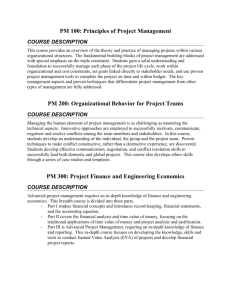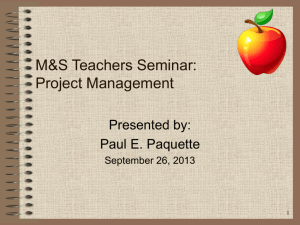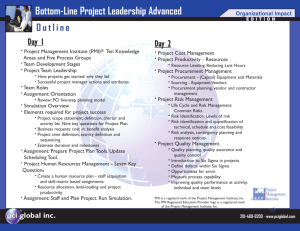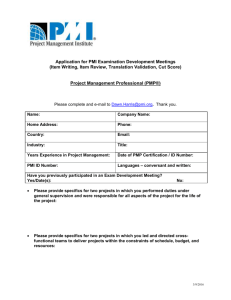Project Manager
advertisement
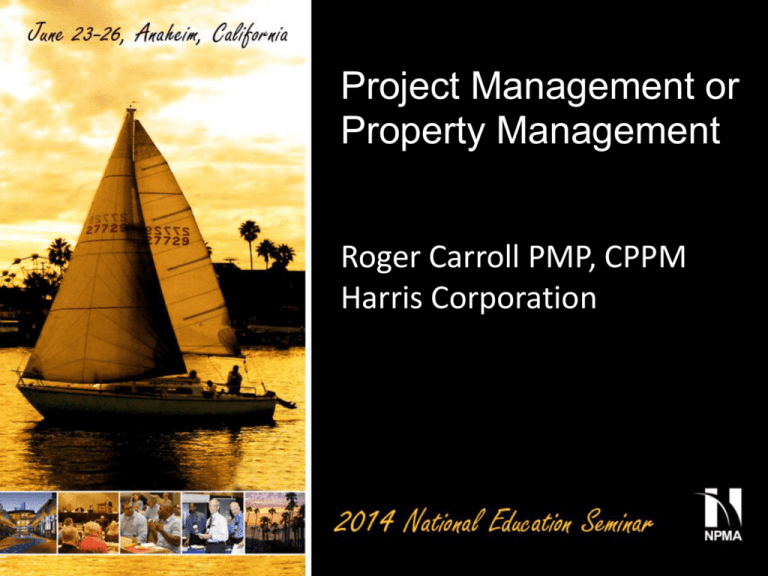
Project Management or Property Management Roger Carroll PMP, CPPM Harris Corporation Learning Objective • At the end of this session you will: • • • • Understand the basic of Project Management and the PMP certification process. Understand how Project Management processes can assist in Property Management. Tools of Project Management and how they can be used in Property Management Application of Project Management processes during Government audits and special projects Why Project Management? Why Project Management How often does the Property Manager act as a Project Manager and how often is the property group heading up projects? – Implementing a new Property Management System (NEMS/SAP) – New contracts – Audits – Contract Changes – New Contract Requirements (FAR Changes, PICS) – Audits – Procedure re-writes – Audits – Financial Reporting – Audits What is a PMP? • The Project Management Institute (PMI) is a not for profit organization for the project management professional with the purpose of advancing project management. • Launched in 1984, PMI's first certification was the PMP. Around 370,000 people now hold the PMP certification. In 2007, it earned the ANSI/ISO/IEC 17024 accreditation from the International Organization for Standardization (ISO). • To initially obtain a PMI credential, candidates must document that required education and experience requirements. • Candidates must pass an examination consisting of multiple choice questions. 200 questions and four hours to take. (VERY HARD TEST) • Credentials must be renewed every three years. • Over time, PMI has introduced many other certifications and credentials. A full, updated list can be viewed at PMI official web site http://www.pmi.org. • • • • • • • Certified Associate in Project Management (CAPM)® Project Management Professional (PMP)® Program Management Professional (PgMP)® PMI Agile Certified Practitioner (PMI-ACP)® PMI Risk Management Professional (PMI-RMP)® PMI Scheduling Professional (PMI-SP)® OPM3® Professional Certification • Numerous books on how to pass the PMP test • Numerous Web sites on how to pass the test • Velocitech.com • Passthepmp.com • test-king.com • AMAnet.org • pmperfect.com • Seminars and Boot Camps Basics of Project Management • Project Management is the discipline of planning, organizing, motivating, and controlling resources to achieve specific goals. • A project is a temporary endeavor with a defined beginning and end (usually time-constrained, and often constrained by funding or deliverables), undertaken to meet unique goals and objectives, typically to bring about beneficial change or added value. • The primary challenge of project management is to achieve all of the project goals and objectives while honoring the preconceived constraints. The primary constraints are scope, time, quality and budget. The secondary —and more ambitious— challenge is to optimize the allocation of necessary inputs and integrate them to meet pre-defined objectives. • A Guide to the Project Management Body of Knowledge (PMBOK Guide) is a book which presents a set of standard terminology and guidelines for project management . The American National Standards Institute (ANSI) which assigns standards in the USA, assigned it (ANSI/PMI 99-001-2008). The PMBOK Guide is meant to offer a general guide to manage most projects most of the time. • • • • • • The PMBOK Guide is process-based, meaning it describes work as being accomplished by processes. This approach is consistent with other management standards such as ISO 9000. Processes overlap and interact throughout a project or its various phases. Processes are described in terms of: Inputs (documents, plans, designs, etc.) Tools and Techniques (mechanisms applied to inputs) Outputs (documents, products, etc.) A Guide to the Project Management Body of Knowledge - provides guidelines for managing individual projects and defines project management related concepts. It also describes the project management life cycle and its related processes, as well as the project life cycle. The Guide recognizes 42 processes that fall into five basic process groups and nine knowledge areas that are typical of almost all projects. • The process framework is the structure on which all of PMI’s process material is built. Organized into nine knowledge areas and five foundational process groups – The five process groups are: • • • • • Initiating Planning Executing Monitoring and Controlling Closing – The Nine knowledge areas are: • • • • • • • • • Integration Management Scope Management Time Management Cost Management Quality Management Human Resource Management Communication Management Risk Management Procurement Management • Project – A project is time limited, unique and undertaken for a purpose. • Program – A program is a larger effort than a project because it is a group of related projects coordinated together • Progressive Elaboration – Means that you do not know all of the characteristics about a product when you begin the project • Project Life Cycle – Is a representative of the phase that a typical project goes through. • Project Manager – The PM is the person untimely responsible for the outcome of the Project. • • • • Formally empowered to use resources In control of the project Authorized to spend money Decision maker for the project • Project Manager’s – Power • Depends on the type of organization ( see next slide) – Project Managers Skill set • Leading • Communicating • Negotiating • Problem solving • Influencing • Stakeholder – Stakeholders are the individuals who are involved in the project or whose interests may be positively or negatively affected as a result of the completion of the project • The Triple Constraint – The triple constraint or the iron triangle is simply the concept that scope, time and cost are closely related and changing any one of these and they are all effected. Organizational Structures Type Description In Charge Benefits Drawbacks Functional •Very Common •Work for a department •May be loaned from another department •Project management has low influence or power •Functional manager in charge •High degree of specialization •Deeper company expertise by function •Defined career paths for team members •Project manager is weak •Projects have a lower priority •Resources are often not dedicated to the project Projectized •Organization is structured by projects •Project Manager in charge •Project manager has complete authority •Project communication is easier •Resources are easily obtained •Team members only report to the project •Limits professional growth •Work yourself out of a job Matrix •A hybrid organization •Can be strong or weak matrix •Power Shared between project manager and functional manager •Can be the best of both worlds •Transfer of information and empowerment easier •High overhead •Report to functional manager dotted lined to another •High probability for contention •Less loyalty • Foundation Terms And Concepts – Common Project life cycle • Project Life cycle is simply a representation of the phases that a project typically goes through. These phases are general, but they are representative of the common flow of activities on a project Planning Conceptual Construction Conceptual closer Planning Implementation Construction Testing Testing Implementation closer Project Management Inputs and Outputs • Inputs are the starting points for the processes. There are specific and unique inputs into each project management process that are used as the building blocks of the processes groups. • Some examples of Inputs: – – – – – Contract requirements Regulations FAR, NASAFAR supplement Information Management Systems Corporate Business Processes Manuals and work instructions • Every process contains at least one output. The outputs are the ends of our efforts. The outcome my be a document (Passing an Audit) a product or services or a result. • Usually outputs from one process can be an input to another. • Examples of outputs – – – – – Project Plan Budgets Schedules Stakeholders Register Audit results letter Graphical Summary • Process 1 Tools & Techniques Inputs Outputs •Process 2 Inputs Tools & Techniques As the above diagram illustrates, the outputs from one process are often used as inputs into one or more processes. Outputs Project Management Tools and Techniques • Tools and Techniques are the actions or methods that are used to transform inputs into outputs. Tools can be many things such as software, corporate knowledge, which can be used as a tool to help plan a project and analyze the schedule. Techniques are methods, such as flowcharts, which help us to frame, approach and solve problems. These are combined since they both are used to solve problems. • Common Tools – – – – Software systems Expert knowledge Consultants or outside professionals Ishikawa diagrams or cause & effect diagrams • Common Techniques – Creating teams – Brain storming – Leadership styles Project Management Processes & Knowledge Areas Process Group Knowledge Areas Initiating Planning Executing Mon/Control Closing Integration •Develop Project Charter •Develop Plan •Direct and Manage Execution •Monitor & Control •Integrated Control •Close Project or Phase Scope •Collect Req •Define Scope •Create WBS •Verify Scope •Control Scope Time •Define Activities •Sequence Activities •Estimate resources •Duration •Develop Schedule •Control Schedule Cost •Estimate Cost •Budget •Control Cost Quality •Plan Quality •Perform QA Human Resource •Develop HR plan •Acquire team •Develop team •Manage team •Plan Comm. •Distribute Information •Manage Stakeholders •Report Performance •Conduct Procurement •Administer Procurement Communications Risk •ID Stakeholders •Perform Quality Control •Plan Risk •ID Risk •Qual & Quant Analysis •Risk Response Procurement •Plan Procurement •Close Procurement • The Project Charter is basically your marching orders! Initiating Integration Develop Project Charter Scope Time • Identification of stakeholder Cost Quality H/R Comm. Risk Procurement – It’s what you are going to do • Build a Bridge • Develop New Software • Manage Government Property • Audits Identify Stakeholders – Customers – Upper management – Functional managers • Inventory control manager • Warehouse manager – Custodians – Users • Integration Planning Integration Develop the Plan Scope Collect Requirements Define the Scope Create WBS Time Define Activities Sequence Activities Estimate Activity resource Estimate Duration Develop Schedule Cost Estimate Cost Determine Budget Quality Plan Quality H/R Develop H/R Plan Comm. Plan Communication Risk Plan Risk Identify Risks Perform Qualitative Analysis Perform Quantitative Analysis Plan Risk Response Procurement – Develop the plan • How are you going to handle the Audit • Scope – Collect the requirements • What's going to be audited • What contract • What is the auditor going to audit – Define Scope • Universe • Sample size • Sample dates – Create WBS • Does not easily apply Planning Integration Develop the Plan Scope Collect Requirements Define the Scope Create WBS Time Define Activities Sequence Activities Estimate Activity resource Estimate Duration Develop Schedule Cost Estimate Cost Determine Budget Quality Plan Quality H/R Develop H/R Plan Comm. Plan Communication Risk Plan Risk Identify Risks Perform Qualitative Analysis Perform Quantitative Analysis Plan Risk Response Procurement • Time – Define Activities • What do we need to do • How do we prepare – Sequence Activities • What are we doing first, second • Which Location, building, room – Estimate Activity Resources • How many people will • Cost Planning Integration Develop the Plan Scope Collect Requirements Define the Scope Create WBS Time Define Activities Sequence Activities Estimate Activity resource Estimate Duration Develop Schedule Cost Estimate Cost Determine Budget Quality Plan Quality H/R Develop H/R Plan Comm. Plan Communication Risk Plan Risk Identify Risks Perform Qualitative Analysis Perform Quantitative Analysis Plan Risk Response Procurement – How many man hours are spent in support of an Audit • Quality – Plan Quality • How are you going to ensure the data given to the auditor is accurate • How do you insure the data given to the auditor is what is needed • H/R – Develop HR plan • Employee minimum qualifications • Cross training • Continued training of property personnel • Certifications • Communications Planning Integration Develop the Plan Scope Collect Requirements Define the Scope Create WBS Time Define Activities Sequence Activities Estimate Activity resource Estimate Duration Develop Schedule Cost Estimate Cost Determine Budget Quality Plan Quality H/R Develop H/R Plan Comm. Plan Communication Risk Plan Risk Identify Risks Perform Qualitative Analysis Perform Quantitative Analysis Plan Risk Response Procurement •Plan Procurements – Plan Communications • How are you going to get the information out to the right people at the rights time. • Too much information • Feed back • Noise • Risk – • – • • – Plan Risk Problem solving skills Identify Risk Pre audit / walk-downs Contractor self assessments Perform Qualitative and Quantitative Analysis • Metrics used heavily – Plan Risk response Executing Integration •Direct and Manage Project Execution Scope Time Cost Quality •Perform Quality Assurance H/R •Acquire Project Team •Develop Project Team •Manage Project Team Comm. •Distribute information •Manage Stakeholders expectations Risk Procurement •Conduct Procurements • Integration – Direct and Manage Project Execution • How do you ensure all activities are being performed • Changes • Start to finish – All ten outcomes • Quality – Perform Quality Assurance • Review of data • Right information • Executing Integration •Direct and Manage Project Execution Scope Time Cost Quality •Perform Quality Assurance H/R •Acquire Project Team •Develop Project Team •Manage Project Team Comm. •Distribute information •Manage Stakeholders expectations Risk Procurement •Conduct Procurements • Human Resources – Acquire Project Team – Develop Team – Manage Team • Team focused on project • Right people doing the work • Tools needed to complete the work Communication – Distribute Information • Email • Flyers • Phone calls – Manage Stakeholders expectations • What information is top management looking for? • Reports • Perfect audit or close enough • Integration Monitoring & Controlling Integration •Mon/Cont Project Work •Perform Integrated Change Control Scope •Verify Scope •Control Scope Time •Control Schedule Cost •Control Cost Quality •Perform Quality control H/R Comm. •Report Performance Risk •Monitor & control Risks Procurement •Administer Procurements – Monitor & control Project Work – Perform Integrated change control • Capture changes, update plans • Making sure the changes are documented and communicated • Scope – Verify Scope • What is being audited • Make sure within contract – Control Scope • Validate contract specific • Time – Control Schedule • Update schedule as needed • Cost Monitoring & Controlling Integration •Mon/Cont Project Work •Perform Integrated Change Control Scope •Verify Scope •Control Scope Time •Control Schedule Cost •Control Cost Quality •Perform Quality control – Minimal impact for Property • However the capturing of any project cost helps determine future needs/constraints. • Key Part of the Triple Constraint • Quality – Perform quality control • Reviewing of the data • Communication H/R Comm. •Report Performance Risk •Monitor & control Risks Procurement •Administer Procurements – Report Performance • Different levels of management are looking for different communication. • Risk – Monitor & control • Integration – Close Project or Phase Closing Integration •Close Project Scope Time Cost Quality H/R Comm. Risk Procurement •Close Procurements • The group of process that focus on closing out the project. Closing processes focus on closing out the contract, releasing resources and delivering the product and gaining formal approval or acceptance from stakeholder. • Audit completion to include corrective actions • PMI’s Process Groups as it relates to a Property Audit Initiating Planning •Receipt of Audit Letter •Scheduled Audit •Communicate with Stakeholders Monitoring & Controlling Executing •Entrance Briefing •Procedure review •Walk-downs •Interviews •Communication •What is going to be audited •Define Audit Scope •Determine timelines •Check Data •Make sure you have enough people to support •Communication •Clean up records Closing •Exit Briefing •Closeout letter •Corrective Actions •Entrance Briefing •Procedure review •Walk-downs •Interviews •Communication Summary • Project Management Basics – The five process groups are: • • • • • Initiating Planning Executing Monitoring and Controlling Closing – The Nine knowledge areas are: • • • • • • • • • Integration Management Scope Management Time Management Cost Management Quality Management Human Resource Management Communication Management Risk Management Procurement Management Summary • Project Management Basics – Inputs – Tools and Techniques – Outputs Applying Project Management Process to the Ten Property Outcomes Acquisition Relief of Stewardship Receipt Contract Closeout Records Reports Subcontractor Control Initiation Physical Inventory Utilization Closing Planning Maintenance Monitoring and Controlling execution
